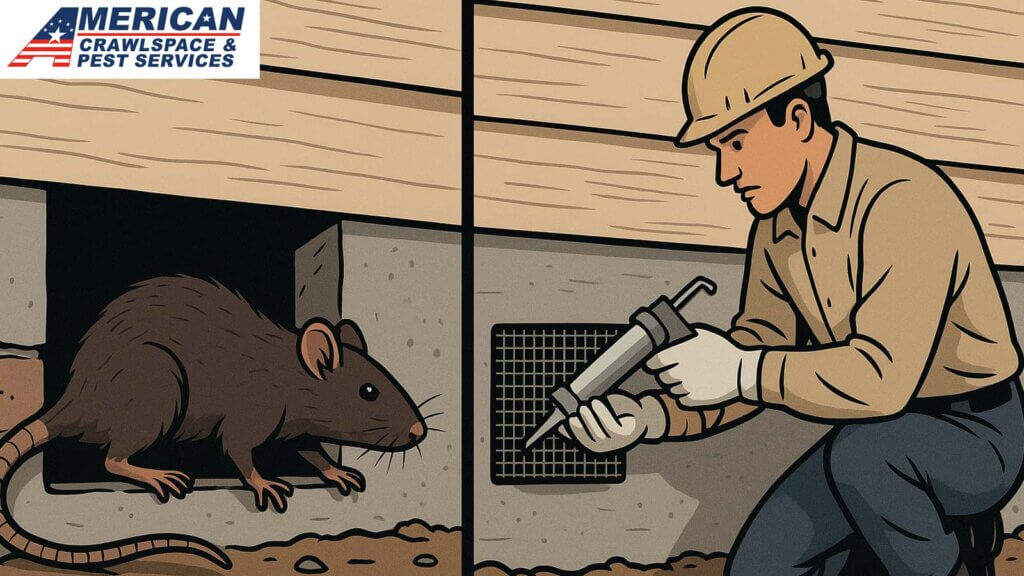What Rodent Exclusion Really Means
Rodent exclusion isn’t just trapping mice or rats once they invade. It’s about denying them entry in the first place. At its core, rodent exclusion is proofing your home—especially crawlspaces and attics—so rodents can’t get inside where they cause damage, degrade insulation, or harm air quality.
1. Identify All Entry Points, Seen and Hidden
Rodents are clever. They can squeeze through holes smaller than a quarter. They climb, jump, and squeeze into tiny gaps. Common access points include:
- Openings where plumbing, wiring, or utility cables enter your home
- Gaps in crawlspace access doors or vents
- Cracks in foundations or attic vents
- Roofline gaps or damaged siding
A full rodent exclusion service requires walking every inch of the crawlspace and attic. American Crawlspace technicians search for even hard-to-see gaps, then seal them tight.
2. Seal with Durable, Proper Materials
Plugging holes isn’t enough if you use thin, weak materials. Sealant fails, mesh rusts, gaps re-open. For rodent exclusion to stick, we use:
- Steel mesh or hardware cloth for vents and foundation holes
- Metal flashing and durable trim around penetrations
- Proper caulking and weather-stripping for doors/windows
At American Crawlspace, we match material to location so the seal lasts. We don’t use quick-fix materials that fail in weeks or months.
3. Remove Attractants and Nesting Materials
Even sealed homes draw rodents if there is shelter, food, or moisture. They nest in insulation, old debris, stored boxes, cardboard—all things under crawlspaces. They’re drawn to clutter and moisture.
Rodent exclusion includes cleaning out:
- Soiled or damaged insulation
- Wood debris, old cardboard, insulation scraps
- Wet or rotten materials
- Items touching the ground or damp walls
A clean crawlspace and attic make exclusion far more effective.

4. Repair Structural Weaknesses
Some features of your home may work as unintended rodent highways. Weak flashings. Roof overhangs with tree limbs close by. Damaged vent screens. Broken or sagging components.
Rodent exclusion demands these repairs:
- Replace or repair damaged vents, screens, or grille work
- Recommendations to trim back vegetation close to soffits or roofline
- Ensure attic vents are protected and properly sized
These structural fixes stop rodents at the outer shell of the home.
5. Ongoing Monitoring and Maintenance
Rodent exclusion isn’t “set it and forget it.” Over time, materials degrade. Wildlife finds new routes. Weather causes damage.
The American Crawlspace approach includes:
- Regular inspections (crawlspace & attic)
- Monitoring during wet or stormy seasons
- Warranty or protection plans for ongoing exclusion
- Follow-up checks after major weather or structural changes
This prevents small breaches from becoming full infestations.
Why Rodent Exclusion Matters for Homes in the PNW
Our climate adds challenges: wet winters, humid summers, wood framing, older homes with many penetration points. Crawlspaces and attics provide ideal hiding spots. If left unsealed, these spaces worsen not just pests, but mold, moisture, damaged insulation, and even fire risk.
By doing rodent exclusion thoroughly—and combining it with our crawlspace or attic cleanouts—American Crawlspace helps protect homes from health, structural, and energy issues.
It’s Time for Action
If you’ve seen droppings, heard scratching, smelled mildew, noticed chewed insulation, or suspect rodents, don’t wait. Call American Crawlspace. We’ll perform a full rodent exclusion, clean what needs cleaning, and seal your crawlspaces and attic against invaders. Schedule your free inspection today.
